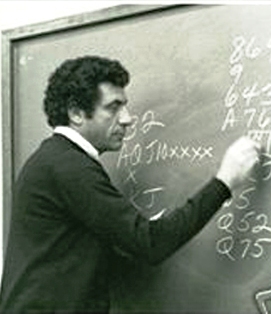

Source: http://cdn.acbl.org/nabc/2018/02/bulletins/db10.pdf
Dealer West. N/S Vul
|
|
||
|
|
|
|
|
|
| West | North | East | South |
| Pass | Pass |
1 |
2 |
|
2 |
3 |
4 |
Pass |
| Pass | Pass |
Opening lead: ![]() 4
4
Bidding commentary: As South, your 2 ![]() * jump overcall is equivalent to an opening weak two-bid. As North, you have enough to give partner a single raise. As East, you are too strong to raise to 3
* jump overcall is equivalent to an opening weak two-bid. As North, you have enough to give partner a single raise. As East, you are too strong to raise to 3![]() .
.
You have a side-suit singleton, phenomenal trump support plus a strong side suit. Please.
 Eddie Kantar
Eddie Kantar
Defensive commentary: As South, you should recognize this dummy type – one with a powerful side suit plus strong trump support. Defensive tricks must be taken or established quickly. Clearly clubs is the suit to attack.
The question is: which club to lead? When the dummy to the right has the 9-x-x-(x) and you have the Q-10-8-(x) or the K-10-8-(x), you have the 9 surrounded with the 10-8 plus a higher unequal honor, the ingredients for a “surrounding” play.
Attack with the 10, the higher of the two surrounding cards and the only card in your hand that defeats the contract. Your lead establishes two club tricks before the ![]() A can be driven out.
A can be driven out.
Assuming West covers with the ![]() J (best), North wins and returns a club. You remain with the
J (best), North wins and returns a club. You remain with the ![]() K 8 over dummy’s
K 8 over dummy’s ![]() 9 7. By covering the 7 with the 9 and the 9 with the king, you drive out declarer’s ace while retaining a club winner.
9 7. By covering the 7 with the 9 and the 9 with the king, you drive out declarer’s ace while retaining a club winner.
When partner gets in with the ![]() A, a club return defeats the contract. If you lead the
A, a club return defeats the contract. If you lead the ![]() 8, declarer plays low, partner wins the queen, but declarer remains with the A-J hovering over your king.
8, declarer plays low, partner wins the queen, but declarer remains with the A-J hovering over your king.
Leading the king doesn’t work either. Declarer wins the ace, draws trumps and drives out the ![]() A, all the while retaining a club stopper.
A, all the while retaining a club stopper.
Other surrounding plays to be on the lookout for are: (1) leading the J from the AJ9(x) or the KJ9(x) when dummy to the right has the 10-x-(x); (2) leading the Q from A-Q-10-(x) when dummy to the right has the J-x-(x).






